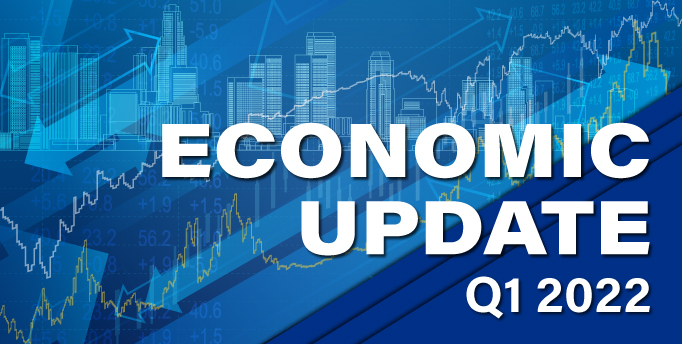Economic Update Q1 2022

The General Economy
The economy in the first quarter of 2022 was battered by many forces, from a surge in COVID cases to disruptive weather and then the shock of the war in Ukraine. The latter jolted gas prices and fueled inflation further; the Consumer Price Index (CPI) hit a 40-year high in February at a 7.9 percent annualized rate. Inflation was wide-ranging, reflected not only in gas, food and shelter prices, but also clothing and recreation items. Broad, prolonged price increases are a particular hazard; they can erode the advances made in incomes.
Average hourly earnings improved dramatically over the last year, but this “nominal” figure does not reflect true purchasing power. When the CPI is considered, the “real” number shows that inflation-adjusted wage growth turned negative. This wallet pinch impacted consumer sentiment. Consequently, economists downgraded their forecasts for annualized Gross Domestic Product (GDP) growth significantly. Fannie Mae now places GDP expansion for the quarter at just 0.8 percent.
Apprehension over rocketing prices and war-exacerbated supply chain issues overshadowed some solid strengths of the economy. The current wave of Omicron ebbed, bolstering personal expenditures on services. The number of people out of work because their employer was impacted by the pandemic dropped by over 60 percent in March. The labor market remained tight; the unemployment rate diminished to 3.6 percent in March. It was business investment, set to expand 8.7 percent, that supplied the vigor for the economy. Companies built inventories and managed to boost industrial production, despite the persistent shortage of key components.
The Real Estate Sector
Residential
The housing market experienced another good quarter, but there were definite signs of moderation. Millennials, who are hitting their first-home buying years, and the strong employment situation supported existing home sales, which remained about 6.2 million units on an annual basis. Fears of future climbing interest rates and escalating home valuations kept sales robust in the traditionally weaker winter buying season.
However, the National Association of REALTORS® (NAR) reported that existing home inventory was in short supply, hitting a record low in January. The pace of starts was hindered by delays in material delivery. In February, of the 407,000 new homes available for sale, only 35,000 were completed. Price appreciation was once again in the double digits. Monthly average mortgage rates climbed significantly to 4.17 percent, up more than 1.0 percent over the quarter, in anticipation of the Federal Reserve’s decision to boost interest rates to fight surging inflation. Consequently, total dollar originations were off nearly 23 percent from last quarter, as refinancings plummeted.
In this environment, concerns over affordability of the housing stock grew. The National Association of Home Builders (NAHB) estimates that in 2022, more than 1.1 million households will be priced out of the market for every 25 basis points added to the mortgage rate of 3.5 percent. There is an inventory squeeze on the lower end of the market, exacerbating the cost pressures. A recent NAR report* stated that there are nearly 411,000 fewer homes available now than before the pandemic for households earning between $75K and $100K. In February, the Federal Housing Finance Agency (FHFA) announced a $1.1B program to support affordable home production. But relief is likely a ways off, given that the private sector has struggled to get houses completed with any swiftness.
Commercial Real Estate
The robust rebound in the commercial real estate market continued into the first quarter of this year; deal volume at $38.5B is up 34 percent over the last year, according to Real Capital Analytics. Transaction prices reached new highs for many sectors in February, propelled by the return of investor participation. Industrial and apartment buildings were once again the stars of the quarter.
March became “the return to the office month” for many companies, with mask mandates lifted across the country. However, managers faced a new challenge: competing with the comforts of home. According to a recent Pew Research survey**, 61 percent of teleworkers are choosing not to go into the workplace, even if it is open. Thus, companies are focusing on space that is enticing, both in regard to health standards and amenities. This emphasis bolstered demand for premium space and properties built in the last five years, according to JLL. Older spaces – whether city or suburban – that could not provide upgraded ventilation, smart office technology, or meet environmental certifications found it a harder market. But renovations to buildings are difficult in a time of construction constraints. The flight to quality may be a nagging concern for owners of outdated office space.
A Glance Forward
When the Russian invasion of Ukraine stole headlines in February, economists lowered their forecasts for the second quarter of 2022. March projections for second quarter GDP growth dropped over a point to 3.1 percent. Consumer spending is expected to falter due to the erosion of real wages and intensified uncertainty in the world. The Federal Reserve (the Fed) signaled multiple rate increases over the course of the next year of at least 0.25 percent each. The words “stagflation” and “soft landing” slipped into economists’ commentaries soon after. Will the Fed’s moves overwhelm the economy into a recession and reverse employment gains, or will they cool it down just enough? It’s too early to tell; it will take several months for the Fed’s actions and the current economic shocks to take effect.
Thus, the annual CPI should moderate only slightly to 7.5 percent, according to Fannie Mae. The spring home buying season is expected to still see its traditional healthy demand and home building but higher mortgage rates (expected to rise another 40 basis points) will most likely temper total homes sales growth.
So, spring may not be as rosy as foreseen just in February. However, unlike decades ago when oil prices were skyrocketing and inflation was soaring, the employment situation appears healthy. Both residential and business investment are forecast to swell over 8.0 percent next quarter. As the Chair of the Federal Reserve recently stated, aggregate demand is strong, the labor market is strong, and business and home balance sheets are strong. There is belief that the underlying hardiness of the economy will see us through.
* Copyright ©2022 “February 2022: The ‘Double Trouble’ of the Housing Market.” NATIONAL ASSOCIATION OF REALTORS®. All rights reserved. Reprinted with permission. April 2022, https://cdn.nar.realtor/sites/default/files/documents/2022-the-double-trouble-of-the-housing-market-02-07-2022.pdf.
** Pew Research Center bears no responsibility for the analyses or interpretations of the data presented here. The opinions expressed herein, including any implications for policy, are those of the author and not of Pew Research Center.
